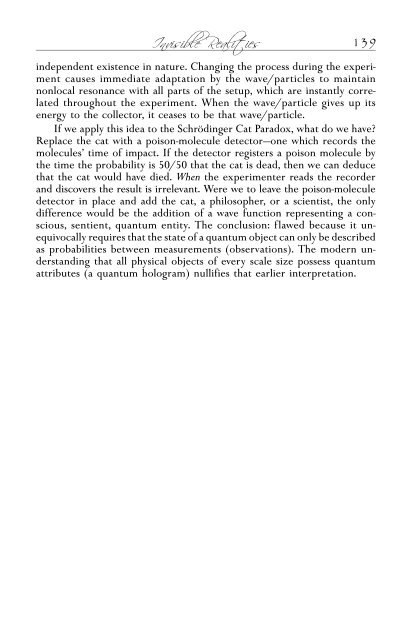edgar-mitchell
edgar-mitchell
edgar-mitchell
Create successful ePaper yourself
Turn your PDF publications into a flip-book with our unique Google optimized e-Paper software.
70<br />
The Way of the Explorer<br />
the landing site was relatively smooth, the overlapping of ancient craters left<br />
ridges often 2 meters high that hid the navigation points. Micronavigation<br />
(knowing our location within a few meters), as desired by the geology<br />
team in Houston, proved to be impossible with the equipment at hand.<br />
Distances became plastic due to the nearness of the horizon on this small<br />
planet and the unreal clarity of the airless scene before us. Our estimates<br />
of distance were in error by 100 percent, as objects typically appeared to<br />
be at half the distance they really were. And there were other problems to<br />
be surmounted. The stiff pressurized suits fought each intricate movement<br />
as we conducted the delicate tasks of documenting and collecting samples<br />
and performing soil experiments. We were Earthlings in a world that possessed<br />
its own dimensions.<br />
As we mounted the gentle slope and were climbing in earnest, we<br />
were more than twice as far from our LM as any of our predecessors had<br />
been, yet less than halfway to the summit, and several minutes behind our<br />
time line. The precious minutes lost in the futile search for landmarks and<br />
the exhausting climb caused our heart rates to climb also; because of this,<br />
consumables in the life-support system diminished at a faster rate. But<br />
things would work out—just a little more slowly than had been so rigidly<br />
planned. We took comfort in the fact that the work was getting done in<br />
good fashion, in spite of the obstacles. And there was comfort to be had in<br />
the sight of Antares squatting in the distance below us, ready to provide<br />
safe haven if needed.<br />
As we slowly bounded along in the strange bouncing gait required on<br />
the lunar surface, strangely cheerful yet frustrated, I suddenly recognized a<br />
distinctive landmark I thought we’d already passed. With grim reluctance I<br />
told Fred Haise in Houston that all of our previously reported positions<br />
were in doubt. As our hearts raced and our lungs gave our blood precious<br />
oxygen, carried through 250,000 miles of space, the frustration grew. There<br />
was very little Houston could tell us, so we continued the climb, sometimes<br />
carrying the MET, as it bounced menacingly in the reduced gravity<br />
over the rough terrain. All the while, the summit of Cone Crater refused<br />
to reveal itself.<br />
A few minutes later Fred’s voice pierced the quiet, sounding grave<br />
through the vast emptiness. He was about to have us turn back, we knew,<br />
but from what we could tell from the map and what we saw above us, the<br />
summit of the rim couldn’t be much further. We asked for a little more<br />
time, almost pleaded; what lay ahead was something neither Alan or I<br />
could surrender easily. This was what we had come here for. If we turned<br />
back now, it was lost to us forever. Houston seemed to understand this. A<br />
few more minutes of laborious breathing passed, and we received the happy<br />
news of a reprieve of 30 minutes to see if we could reach the rim. The<br />
flight surgeon in Houston merely requested that we take a minute to rest,<br />
as he saw our hearts racing on the monitor.


